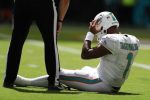How QB helmet cams can give NFL teams an edge

What’s said in an NFL huddle, stays in the huddle. Unless, of course, the quarterback is wearing a helmet cam with audio capabilities.
“It’s almost like, you think of the integrity of the huddle,” Miami Dolphins quarterback Tua Tagovailoa said. “Like, do I really want the coaches to hear what I’m saying to the guys?”
Dolphins coach Mike McDaniel and his staff believe Tagovailoa’s desire to keep certain things private is outweighed by the value the information can provide to the coaches, as well as to Miami’s other two — less experienced quarterbacks — in recently acquired Mike White and second-year QB Skylar Thompson.
Pittsburgh Steelers second-year quarterback Kenny Pickett also wore a helmet cam this spring as coaches were able to see what their QB was seeing, and what informed the decisions he made on each play.
“For us, it’s multifaceted,” McDaniel said. “It’s a camera, but it does have audio, and I think some of the strong attributes of that technology are that you get to hear playcalls. You can library those playcalls for players to hear when they’re studying. A lot of colleges and high schools don’t [huddle], which means you’re taking in information auditorily for the first time … as opposed to looking at the sidelines for a signal or a picture.
• Will the Bengals be dethroned in AFC North?
• Ravens look to build off Roquan Smith
• A look at the Saints’ backfield situation
• Chargers’ Allen talks ‘The Masked Singer’
• Training camp schedules for every team
“It’s also something that you can see from his side eye what he’s looking at. For all quarterbacks, it’s a tool to help really drive home certain coaching points and just see what they’re seeing, to be on the same page as the player.”
Sometimes the footage isn’t exactly illuminating.
“It’s just hard to see, honestly, through the camera with bodies in your face and stuff,” Pickett said. “But there’s some things you can take from it, kind of like where I’m starting with my eyes and stuff.
“So it’s been good.”
The technology isn’t new. The Arena Football League had helmet cams in 2014, and colleges have been using them for years. Chicago Bears quarterback Nathan Peterman wore one in college at Pitt and in the NFL with the Tennessee Titans and Las Vegas Raiders.
“I think it was more for the coaches to see where your eyes are at,” Peterman said. “And also, some of it, was to get a feel for what goes on in the huddle, for the coaches to see the communication of how things are going. That’s what I know (then-Raiders coach Jon) Gruden was looking at, to see the communication in the huddle and checks at the line.”
Tagovailoa had some fun with the concept on the last day of training camp when he placed an old-fashioned Polaroid camera on his helmet. At least with that helmet cam, he didn’t have to worry about coaches hearing what he said in the huddle.
“Because sometimes you might not like a play,” he said. “and you go into it and you tell the guys how you feel, but you basically tell the guy, ‘Hey, I’m skipping this progression to come to you so you better be there.’
“But it gives audio for a lot of the new guys, so that they can listen to the play over and over and over from the guy giving the play. Then they can listen to the cadence. That’s something that’s been big this offseason for us, is operation.”
Pickett joked that he would like to put a camera on the helmet of safety Minkah Fitzpatrick to get the perspective of a defender, but Steelers coaches are more interested in getting inside the head of their 25-year-old quarterback.
“Just always looking at any type of edge, any type of advantage. This is the time of year to do that,” Steelers quarterbacks coach Mike Sullivan said during OTAs. “It’s the time of the year to improve, to lay the foundation, to really set the stage for where we want to go. And that’s just an extra tool that we’re still fine-tuning it, trying to get a sense of, because what it does is — it gives a vision of how he sees it.
“It’s not perfect. I mean it’s not like having an iPhone back there, but it does give a perspective so that from a pre-snap standpoint gives us a chance to see, ‘OK, Hey, you were looking here, what did you see? What were the tells by the alignment of the linebackers or where this player was, what have you?’ And then we’ve been able to intercut it or overlay it with that, his vision. So it’s just an additional resource, an additional teaching tool … Anything that we can do to help that young man take that next step we’re going to do.”
ESPN Steelers reporter Brooke Pryor and Bears reporter Courtney Cronin contributed to this story.